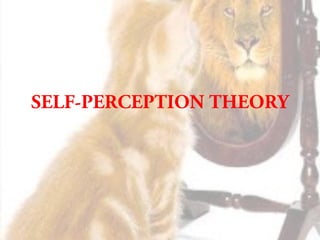
Self perception theory
- 2. PERCEPTION •The way in which something is regarded, understood, or interpreted. SELF PERCEPTION •The idea that you have about the kind of person you are.
- 3. DARYL J.BEM Born in June 1938. Studied Physics at Reed College. Studied social psychology at the University of Michigan Received his PhD in 1964. Taught at Stanford, Carnegie-Mellon, Harvard, and Cornell. Served as consulting editor for psychology-related publications including Journal of Personality, and Psychological Review.
- 4. THEORY •Attitude follows behavior. •It asserts that people develop their attitudes (when there is no previous attitude-due to a lack of experience, etc.—and the emotional response is ambiguous) by observing their own behavior and concluding what attitudes must have caused it.
- 5. •Traditional view about attitude: -Behaviour follows attitude •Bem’s view: -Attitude follows behaviour
- 7. Intrinsic & Extrinsic Motivation •Whether are behaviour is motivated by intrinsic or extrinsic factors has far-reaching implications. •Intrinsic motivation is the desire to engage in an activity because we enjoy it, or find it interesting. •Extrinsic motivation is the desire to engage in an activity because of external rewards or pressures.
- 8. Over justification Effect: •An interesting sidelight to self-perception theory is the over justification effect: •Definition: minimal rewards lead to high interest in a task; external rewards for tasks lead to low interest in it.
- 9. Behavior: 9 year old Johnny plays baseball with the neighborhood kids all day. + Environment: He receives no external reward for doing this = Cause: he plays baseball because it is fun
- 10. Behavior: 25 year old Johnny is playing baseball in the Major Leagues + Environment: he receives $5 million a year to play baseball = Cause: he is playing for the money (environmental cause) not for pleasure (personal cause)
- 11. •The original purpose of self perception theory was to explain phenomena covered by cognitive dissonance theory, without using an internal drive state (dissonance) in the explanation
- 12. •Self perception theory argues that people examine two things when making decisions about the cause of their own behavior. •First, The behavior itself •Second, The environmental forces working on the individual
- 13. Observed Behavior + Environmental Forces = Attributions for the Cause of the Behavior (ATTITUDE)
- 14. Behavior: I told the guy that I liked the experiment + Environment: I got $20 for it = I hated that experiment
- 15. •In the $20 case, the money is a strong explanation for the behavior. Why should I have to be offered so much money to tell the guy that I liked the experiment? Because I must dislike it. •Strong environmental cause implies lack of personal desire to perform the behavior.
- 16. Behavior: I told the guy that I liked the experiment + Environment: I got $1 for it = Cause: The experiment was okay
- 17. •Here, there is very little environmental explanation for the behavior. •So I must conclude that the cause for my telling the guy that the experiment was fun was personal – I said it was okay because it was okay. •Cogitive dissonance was not used in self-perception theory to explain the behavior. •All it took was examination of the behavior and its circumstances.
- 18. • James Laird conducted two experiments on how changes in facial expression can trigger changes in emotion. • Participants were asked to smile or frown without awareness of the nature of their expressions. •They reported feeling more angry when frowning and happier when smiling.
- 19. •They reported that cartoons viewed while they were smiling were more humorous than cartoons viewed while they were frowning. • Laird interpreted these results as a person’s facial expression can act as a cause of an emotional state, rather than an effect. •Instead of smiling because you feel happy, you can make yourself feel happy by smiling.
- 20. APPLICATIONS PSYCHOLOGICAL TREATMENT: •Self-perception theory - people attribute their inner feelings from their external behaviors. •Treatment by guiding patients to firstly change their behaviors and later the problems. •One of the most famous therapies making use of this concept is therapy for Heterosocial Anxiety.
- 21. MARKETING •Foot-in-the-door technique. •The initial commitment on the small request will change ones self image, therefore giving reasons for agreeing with the subsequent, larger request. • It is because people observe their own behaviors and thus infer they must have a preference for those products.
- 22. MEDICINE The Placebo effect •PLACEBO:Simulated or ineffective treatment •Patients given a placebo treatment will have a perceived or actual improvement in a medical condition
- 23. Challenges and criticisms • Whether people experience attitude changes as an effort to reduce dissonance or as a result of self-perception processes. • It does not hold that people experience a "negative drive state" called "dissonance" which they seek to relieve
- 24. • An early study on cognitive dissonance theory shows that people indeed experience arousal when their behavior is inconsistent with their previous attitude. • Waterman designed an experiment where the cognitive dissonance theory is evident
- 25. • Difficulty is in finding an experiment. • Anthony Greenwald -impossible to distinguish between the two theories. • Zanna and Cooper’s - against self perception theory • Fazio, Zanna, and Cooper in 1977- both cognitive dissonance and self-perception could co-exist. • Snyder-Ebbeson experiment - Self-perception Theory is true.
- 26. CONCLUSION • The cognitive dissonance theory accounts attitude changes -when peoples behaviors are inconsistent -original attitudes are clear. • The self-perception theory is used -when those original attitudes are relatively ambiguous and less important.
- 27. • In contrast to traditional belief, a large proportion of peoples attitudes are weak and vague. • The self-perception theory is significant in interpreting ones own attitudes, whether one would cheat to achieve your goal.